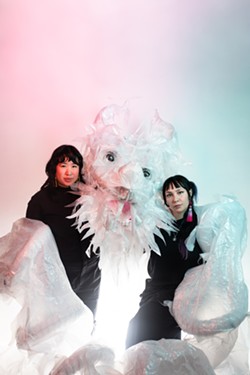For performance and installation artist Stephanie Yee, creation has long been a way of examining identity: It was there thematically in her 2020 sculpture of a non-functioning water fountain, an "imaginary prop" from a fictional 1980s Chinese restaurant she soused in sweet and sour sauce. It was in performance-based work as far back as 2014, with her kneeling between money trees at galleries and making videos where she’d wodge oversized bundles of noodles into too-small pots of boiling water. Now, it’s showing up in her latest piece, a collaboration with Lux Habrich for Nocturne 2021 called "Good Luck To The People."
A 30-foot-long dragon constructed of clear tarp, suspended in a scaffolding frame, Good Luck will be on view from Oct 13-16 (the fest’s duration) on the Halifax waterfront. “It’s clear, it’s ghost-like, there’s no cues of celebration,” says Yee, describing the work. It’s subverting the traditional Chinese dragon dance—something with “so much colour, so much music [and] aliveness” that is then “flattened through the lens of western ideals,” she explains. “Specific images like sweet sour sauce or the dragons become iconic Chinese imagery” to white audiences, stripping them of individuality or nuance.
“I think about this through imagery, because I’m often seen more so as an image—in the way that stereotypes are created. It’s the way that things are, because if you really want to get to know something, you have to take time to forge that relationship and forge connection,” Yee says, when asked how anti-Asian racism has informed her work. “I realized that I reflect in imagery, I reflect in my art and that just reinforced what I needed to do: It reinforced for me that [this is] my way of communicating this pain and confusion.”
“And I think that my way of being able to share my questioning, what's on my mind, is through being able to present something like this dragon, being like: What's it look like when a group of nuanced people have to be forced into a specific definition or a specific space?”

